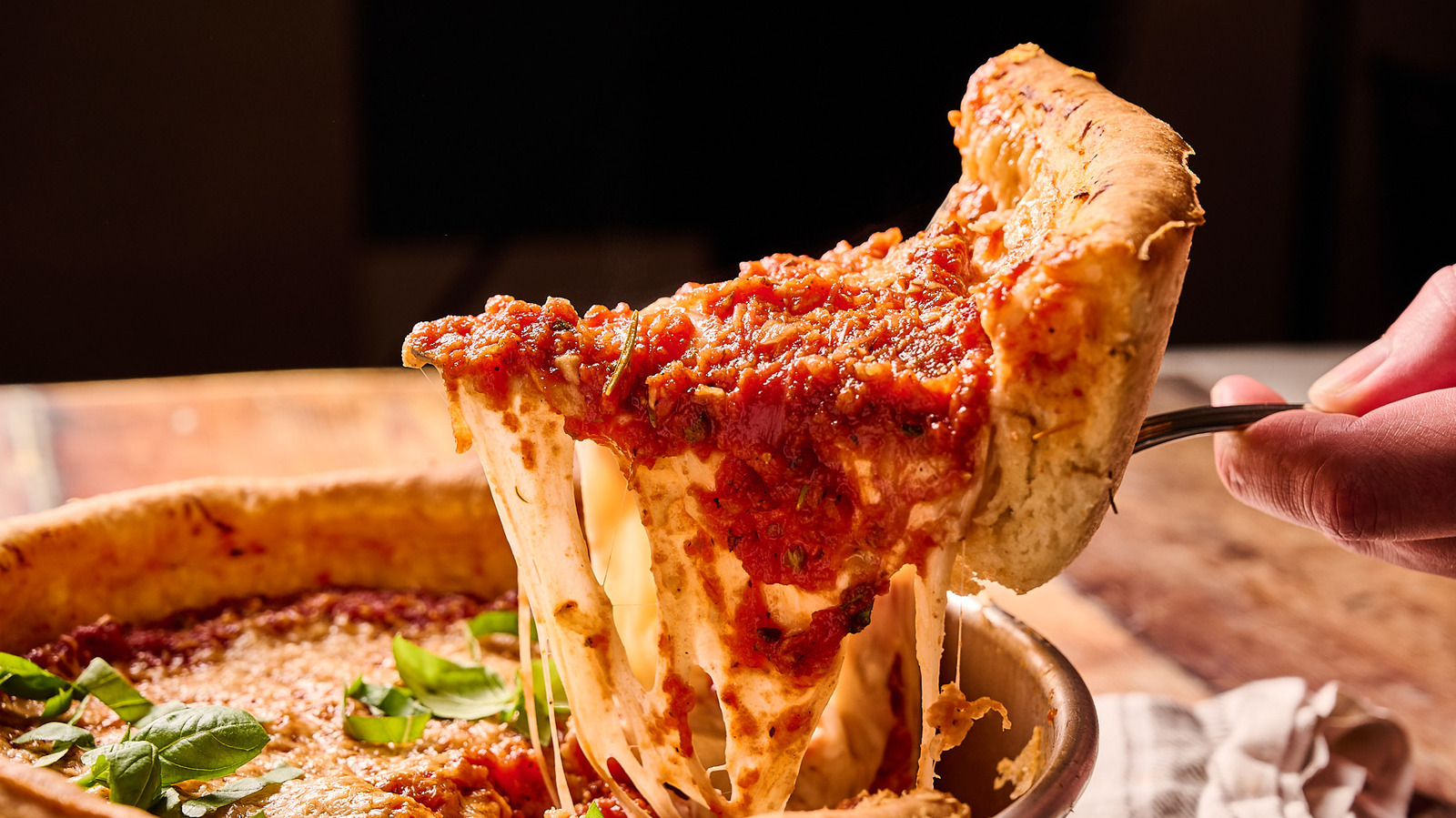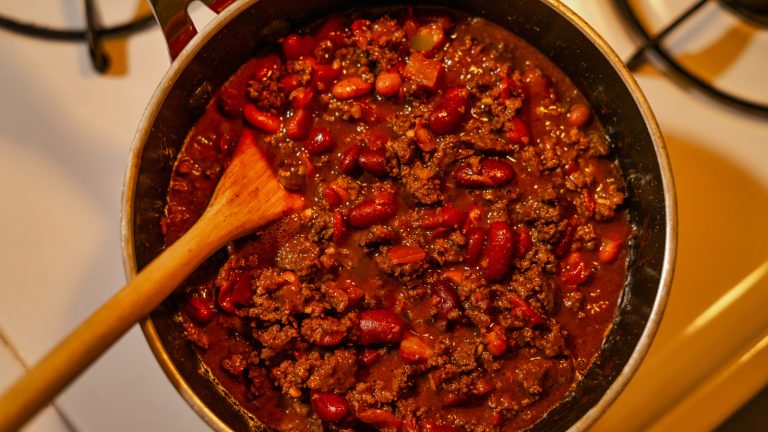Though the city is also famous for beefy Italian sandwiches, tomato-topped hot dogs, and even a thin-crust style of pizza, it’s hard to talk about Chicago cuisine without mentioning deep-dish pizza. Who created the first cheese-filled pie is a little unclear, though it’s largely credited to Pizzeria Uno; what is indisputable is that the pizza style originated in Chicago and, for the most part, stayed there, with authentic versions hard to find across state borders. It’s why Chicago and deep dish are basically synonymous — and why Chicago is still the best place to get a deep-dish pie, hands-down.
At its simplest, deep dish pizza is a dense and doughy crust baked in a round, deep-walled pan and layered with several pounds of cheese and sauce. Some versions include heavy layers of meat, while others opt for adding toppings like tomato and pepperoni. There’s also an unmistakable corn-forward taste and chewy, crispy texture that sets the crust apart from typical pizzas, making it important to start from scratch when making your own deep dish ‘za. This classic Chicago-style deep dish recipe written with Chicago-born developer Michelle McGlinn makes baking deep dish easy with just a few simple tips and tricks (and a lot of cheese) to guide the way, giving you the ability to have your own Giordano’s — or Pequod’s, or Lou’s — right at home.
The ingredients needed to make classic Chicago-style deep dish pizza
To make the crust, you’ll need flour, salt, sugar, corn oil, instant yeast, and water. You can use active dry yeast, but you will need to activate the yeast in the warm water before continuing with the recipe. With the crust made, you’ll need to make a sauce using olive oil, onion, garlic, tomato paste, crushed tomatoes, whole peeled tomatoes, Italian seasoning, and pepper. From there, you just need plenty of low-moisture, melty mozzarella cheese — we like using shredded — some Romano (or Parmesan), and fresh basil.
Step 1: Pulse the dough ingredients to combine
Add the flour, salt, sugar, oil, and yeast to the bowl of a food processor and pulse until just combined.
Step 2: Let rest
Let rest for 15 minutes.
Step 3: Add the water to form a dough
Add the warm water and pulse until a dough is formed, about 30 seconds.
Step 4: Knead the dough
Turn the dough onto a floured surface and knead for 5 minutes. Round the dough into a ball and place it in a large oiled bowl.
Step 5: Proof the dough
Cover the bowl and let the dough rise in a warm location for 2 to 3 hours, or until doubled in size.
Step 6: Heat up the oven
Preheat the oven to 450 F.
Step 7: Heat olive oil in a pan
While the dough is rising, prepare the sauce. Heat olive oil in a large pan over medium heat.
Step 8: Cook the aromatics
Add the garlic and grated onion and cook until fragrant, about 2 minutes.
Step 9: Stir in the tomato paste
Add in the tomato paste and stir to combine.
Step 10: Add the remaining sauce ingredients and simmer
Add the crushed tomatoes, peeled tomatoes, sugar, and Italian seasonings, salt, and pepper and bring to a simmer. Simmer on low heat until reduced by half, about 10 minutes.
Step 11: Oil and dust a pan
Oil an aluminum cake pan with 2 tablespoons corn oil and sprinkle the pan with ¼ cup of the Romano to line the bottom and sides.
Step 12: Roll the dough out
Flip the dough onto a floured surface and gently roll into a large circle about 12 inches in diameter.
Step 13: Press the dough into the pan
Press the dough into the pan, letting the excess fall over the sides. Trim the excess so that the crust ends just before the top of the pan.
Step 14: Fill with cheese
Fill the crust with mozzarella cheese.
Step 15: Layer with sauce
Spoon the sauce over the cheese to fill the pan.
Step 16: Sprinkle with Romano cheese
Sprinkle with Romano cheese on top.
Step 17: Bake the pizza
Add to the oven and bake until the crust is golden brown, 35-40 minutes.
Step 18: Rest, then serve
Remove from the oven and let rest for 20 minutes before serving. Top with basil to serve.
What can I serve with deep dish pizza?
- Everyday Salad With Herby Lemon Vinaigrette Recipe
- Citrusy Arugula Salad Recipe
- Crispy and Crunchy Fried Calamari Recipe
- Caesar Salad Lettuce Spears Recipe
- Roasted Garlic Parmesan Broccoli Recipe
Classic Chicago-Style Deep Dish Pizza Recipe
A Chicago deep dish pizza has a dense crust, deep sides and layers of cheese and sauce, and you can make one in your own home with our easy recipe.
Ingredients
- For the dough
- 3 cups all purpose flour, plus more for working with
- 1 ½ teaspoons salt
- 1 teaspoon granulated sugar
- 4 tablespoons corn oil
- 1 ½ teaspoons instant yeast
- 1 cup warm water
- For the sauce and assembly
- 1 tablespoon olive oil
- 6 cloves garlic, minced
- 1 yellow onion, grated
- 4 tablespoons tomato paste
- 1 (28-ounce) can crushed tomatoes
- 1 (14-ounce) can whole peeled tomatoes
- ½ teaspoon granulated sugar
- 1 tablespoon Italian seasoning mix
- 1 teaspoon salt
- 1 teaspoon pepper
- To assemble
- 2 tablespoons corn oil
- 1 cup grated Romano cheese
- 5 cups freshly shredded low-moisture mozzarella cheese
- Fresh basil, for topping
Directions
- Add the flour, salt, sugar, oil, and yeast to the bowl of a food processor and pulse until just combined.
- Let rest for 15 minutes.
- Add the warm water and pulse until a dough is formed, about 30 seconds.
- Turn the dough onto a floured surface and knead for 5 minutes. Round the dough into a ball and place it in a large oiled bowl.
- Cover the bowl and let the dough rise in a warm location for 2 to 3 hours, or until doubled in size.
- Preheat the oven to 450 F.
- While the dough is rising, prepare the sauce. Heat olive oil in a large pan over medium heat.
- Add the garlic and grated onion and cook until fragrant, about 2 minutes.
- Add in the tomato paste and stir to combine.
- Add the crushed tomatoes, peeled tomatoes, sugar, and Italian seasonings, salt, and pepper and bring to a simmer. Simmer on low heat until reduced by half, about 10 minutes.
- Oil an aluminum cake pan with 2 tablespoons corn oil and sprinkle the pan with ¼ cup of the Romano to line the bottom and sides.
- Flip the dough onto a floured surface and gently roll into a large circle about 12 inches in diameter.
- Press the dough into the pan, letting the excess fall over the sides. Trim the excess so that the crust ends just before the top of the pan.
- Fill the crust with mozzarella cheese.
- Spoon the sauce over the cheese to fill the pan.
- Sprinkle with Romano cheese on top.
- Add to the oven and bake until the crust is golden brown, 35-40 minutes.
- Remove from the oven and let rest for 20 minutes before serving. Top with basil to serve.
Nutrition
| Calories per Serving | 1,848 |
| Total Fat | 114.8 g |
| Saturated Fat | 59.8 g |
| Trans Fat | 0.0 g |
| Cholesterol | 323.4 mg |
| Total Carbohydrates | 109.9 g |
| Dietary Fiber | 10.7 g |
| Total Sugars | 20.0 g |
| Sodium | 3,396.6 mg |
| Protein | 97.3 g |

What is the secret to deep dish pizza crust?
Deep dish pizza crust differs from other styles of pizzas, and it’s hard to describe the difference unless you’ve tried real Chicago deep dish yourself. There’s a distinct corn flavor that some pizzerias achieve by using cornmeal, which also lends to a grittier, denser dough texture than some diners prefer. Others rely on corn oil, which gives a similar flavor without the added texture. To further enhance the corn flavor of the crust in this recipe, you can dust the pan with cornmeal before adding the dough.
Another difference with deep dish pizza dough is the texture, which isn’t soft, fluffy, or even crusty like other pizzas. Deep dish dough is actually more similar to pie or quiche crust, which makes sense given its pie-like usage — and you could use a pie crust recipe in a pinch, though it wouldn’t be quite the same. It would be missing the characteristic chew of a deep dish pizza, which is only achieved by using a little bit of yeast and a higher ratio of oil. The higher fat — in this case, corn oil — slows the gluten formation and leads to a flakier, biscuit-like crust.
How can I customize the toppings in a deep dish pizza?
The most important elements inside a deep dish pizza are the tomato sauce and the cheese, but the toppings can go far beyond that. There are a few things to know before throwing your toppings onto the pie, though. First, most toppings need to be cooked first to avoid excess moisture during the baking process. Extra moisture from peppers, onions, sausage, or spinach can make the pizza watery, leading to overflow and possibly a soggy, unappetizing pie (and it’s also why using low-moisture mozzarella is so important). With the exception of pepperoni, olives, and salami, toss the toppings in a warm pan to cook them briefly before adding them to the pizza.
What’s also good to know is where to put the toppings — because on deep dish pizza, it’s not always on top. This is largely the chef’s choice, but toppings like Italian sausage can be layered underneath the cheese, closest to the crust, or spread in between handfuls of mozzarella. Pepperoni, spinach, and mushrooms can be layered underneath the tomato sauce, where they absorb the flavor of the Italian-seasoned tomatoes. Fresh toppings like basil, tomato, and onion can sit right on top. You can also throw everything on like a regular pizza, too — it will still turn out delicious.
Read More Recipes
- Slow-Cooker Italian Beef Sandwich Recipe
- Detroit-Style Deep Dish Pizza Recipe
- Authentic Chicago-Style Hot Dog Recipe
- Spicy Chicago-Style Giardiniera Recipe
- Bubbly Cheesy Mostaccioli Recipe





